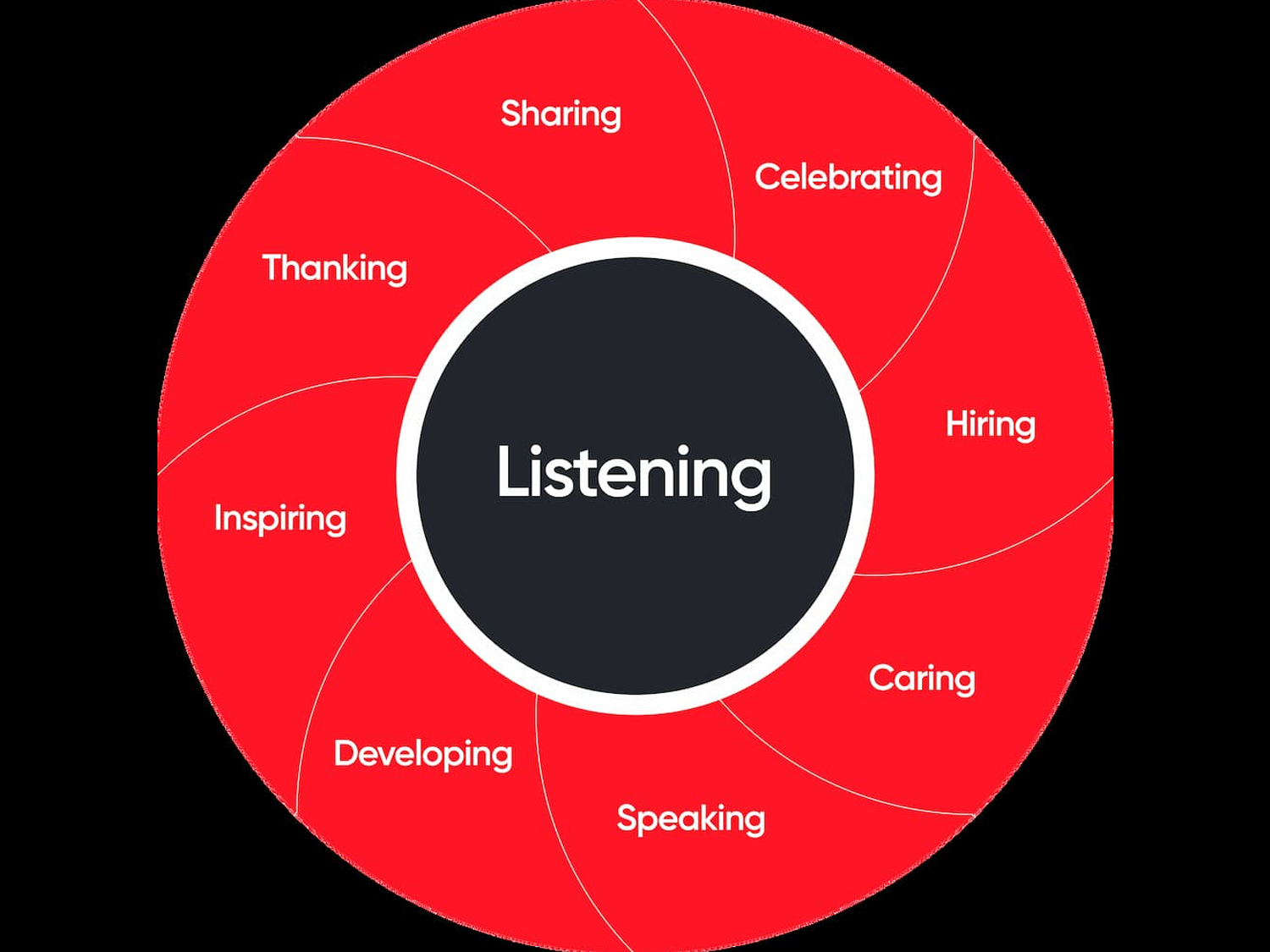High-trust leadership, Speaking
Speaking — one of the nine high-trust leadership behaviors — is about more than what you say, or how you say it.
Communication is one of the primary functions of a leader at any level.
That doesn’t mean you have to be a great “talker” with the affability and style of a used-car salesman. Instead, you have to be a strategic, empathetic, and tireless sharer of the information employees need to hear.
To be someone that others will follow, you must communicate your vision, share updates about progress toward your goals, and make sure every employee knows how they are expected to contribute to those goals. That’s why “speaking” is one of the nine high-trust leadership behaviors Great Place To Work® has identified as the keys to building trust with employees.
Attend our annual company culture conference May 7-9, 2024
“Speaking is more than what you say and who you say it to, it is how you share information,” writes Michael C. Bush, CEO at Great Place To Work. Is your message getting to your desired audience, and is your message delivered in a way that your target audience can easily follow?
Great workplaces share timely information in a variety of channels and formats, ensuring employees understand the bigger picture behind business decisions and promote a culture of transparency.
“Consider your receptionist,” Bush says, pointing to a role that is often invisible to top leaders in the organization. “Whenever you speak with them, reiterate, emphasize, and clarify how important their job is. When someone walks in a building or contacts a receptionist on the phone, that’s a connection to the brand. In a few seconds, a caller or visitor either feels cared for, important, and listened to, or they don’t.”
What great speaking looks like
Here are four best practices that Great Place To Work Certified™ organizations follow to ensure leaders are sharing information broadly and fairly with every employee in the organization:
1. Meet employees where they are, through channels that fit their work and habits
A company should meet employees on their terms, and savvy leaders know that not every employee is going to read an email newsletter.
At DHL Express, a social intranet tool called Smart Connect offers a one-stop shop where employees can find relevant news, strategic updates from management, HR documents and information, a job portal, and more. The tool also has a social wall where everyone can share stories, photos, and videos. The app has more than 100,000 users across the DHL workforce.
World Wide Technology knew that employees on the floor of its integration centers did not have access to regular communication platforms like email or online chat. To reach these deskless employees, the company launched an SMS texting system, ensuring these employees received important business updates and safety notices.
For companies like industrial gases manufacturer Messer, reaching populations like drivers out on the road comes with unique challenges. They need to deliver important information, but do not want to distract their workers while they are driving.
For drivers, each day starts with logging into a company system to check their route for the day.
“When we want somebody to take an action, we’ll put a little pop-up message onto the system because we know our drivers will log into it every day,” says Jem Janik, people and culture communications manager at Messer Americas.
Pop-ups have also been added to HR systems so employees find them when updating their time sheets. Text messaging was added after the team heard from a leader in the engineering services group that their team was more likely to text one another than send an email.
2. Prepare managers to share important information one-on-one
“Speaking” doesn’t require radical transparency. Rather, leaders who are great at speaking think carefully about how information is released throughout the organization.
Regular one-on-one meetings with a people leader ensures that every employee has a personal connection to management and feels that a leader is considering their individual needs. At CarMax, an Associate Connection Plan Guide was developed to ensure regular meetings occurred for every employee at each of its stores.
When sharing information about pay and performance, WP Engine considered how employees would use pay information, not only about their roles, but roles that they hoped to get later in their careers.
The company shares pay range information with employees in the relevant job family, and pay range information for internal opportunities that an employee might be qualified for.
To be successful, WP Engine had to train managers to have one-on-one conversations about pay with employees.
“Some managers are uncomfortable with difficult development conversations, so they’re going to be uncomfortable with difficult pay conversations as well,” says Priya Bhavsar, senior director of total rewards for WP Engine. “But it’s exactly the same thing, because your pay is representative of your performance: how qualified you are for the job, how you’re growing in your role.”
3. Curate the amount of information you share with employees
Great leaders have to also know when they are sharing too much information. Expecting employees to sift through all your communications to find relevant messages doesn’t signal an awareness of their needs and challenges.
Sheetz, a convenience retail chain based in Pennsylvania, took steps to simplify its communication by mapping the employee journey using focus groups to identify all the communication touchpoints. The retailer then simplified, using UKG’s mobile app to streamline corporate communication with hourly employees and removing managers as gatekeepers to communication.
The company also launched an internal communications strategy to create clear guidelines for communication channels, identifying the audiences they serve and the types of information that should be shared through each channel.
4. Set an example with leaders and vulnerability
Leaders can build trust when they demonstrate vulnerability. Great “speaking” includes sharing candidly with employees about challenges facing the business.
When Camden Property Trust had to reorganize and eliminate some roles, the property developer knew it had to bring employees into the process from the beginning. In the face of change, it’s crucial to acknowledge the elephant in the room, says Allison Dunavant, VP, organizational development.
“Acknowledge the change and ask your team members how they’re doing,” Dunavant says. It’s also important to acknowledge when you don’t have all the answers.
“No one expects you to know all the answers or even understand how a change might impact somebody else,” she says.
Rinse and repeat
Great workplaces and the leaders that create them understand that effective communication requires patience and repetition. A message hasn’t been meaningfully shared until it has been digested by your target audience.
The best leaders are those that send messages through a variety of channels, with a focus on consistency and clarity. It’s often just when you’ve exhausted yourself from repeating your message that your point finally starts to sink in.
Benchmark your workplace culture
Find out how your workplace culture stacks up against the most reliable benchmarks available via Great Place To Work Certification™.











